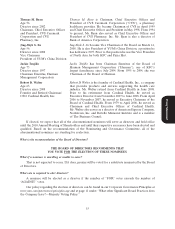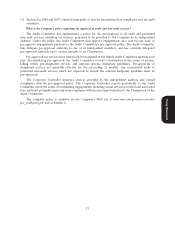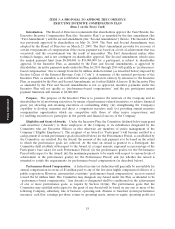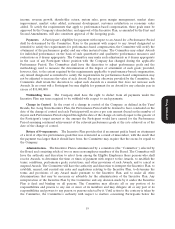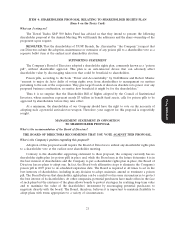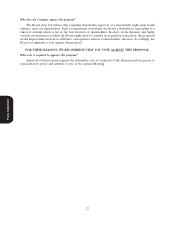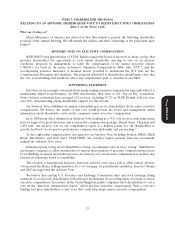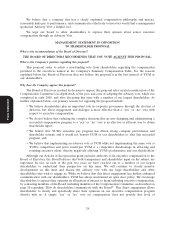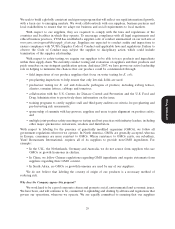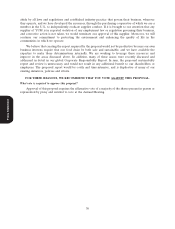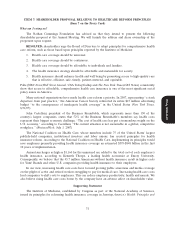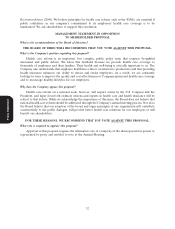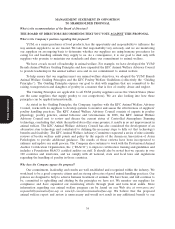Pizza Hut 2008 Annual Report Download - page 43
Download and view the complete annual report
Please find page 43 of the 2008 Pizza Hut annual report below. You can navigate through the pages in the report by either clicking on the pages listed below, or by using the keyword search tool below to find specific information within the annual report.
23MAR200920295069
communication or understanding. This is especially true in the event of a ‘‘no’’ vote on compensation since
the vote alone will not provide any insight into what specific items shareholders are voting against (or why
they voted against it). We believe that our current process of direct engagement already allows an avenue
for discussion of specific concerns regarding compensation. A retrospective advisory vote would not
improve or significantly alter that process of direct engagement.
Our Compensation Committee, which is comprised entirely of independent, non-employee directors,
is responsible for designing and administering our executive compensation program. Decisions on how best
to carry out these responsibilities are influenced by economic and industry conditions, current and future
strategic goals, accounting requirements and tax laws, evolving governance trends, as well as the practices
of our peers and competitors. Reducing a series of complicated decisions by independent directors who are
intimately familiar with all relevant factors to a single, after-the-fact, ‘‘yes’’ or ‘‘no’’ advisory vote is not an
effective or efficient method to obtain shareholder input.
As further discussed in our ‘‘Compensation Discussion and Analysis,’’ our Compensation Committee’s
goal is to use our compensation program to attract, reward and retain the talented leaders necessary to
enable our Company to succeed in the highly competitive market for talent, while maximizing shareholder
returns. Our management team, which has been attracted, rewarded and retained through our
compensation program, has been a key driver in YUM’s strong performance over both the short and long-
term. For example, as shown in the table below, YUM’s investor total return compares favorably against
the S&P 500 Index, a group of nondurable consumer products companies that are used in setting
benchmarks for our CEO’s compensation (as further described on page 49), as well as a select group of
global growth companies including Colgate-Palmolive Company, Kellogg Company, McDonald’s
Corporation, PepsiCo, Inc., Starbucks Corporation, The Coca-Cola Company and The Procter & Gamble
Company, over one, five and ten years.
Investor Total Return(1) Comparison (as of 12/31/08)
1 Year 5 Year 10 Year
YUM! Brands, Inc. .............................. ǁ16% 14% 10%
Proxy Statement
S&P 500 Index .................................. ǁ37% ǁ2% ǁ1%
Nondurable Consumer Products Group(2) ............... ǁ28% ǁ3% 1%
Global Consumer Group(3) ......................... ǁ19% 5% 4%
(1) Compound annual growth rate of stock price adjusted for stock splits and dividends. For the
‘‘Nondurable Consumer Products Group’’ and ‘‘Global Consumer Group,’’ the total investor return
was calculated by taking the average of the total investor returns for all of the individual companies
included in the respective group.
(2) Includes only the publicly-traded companies included in the nondurable consumer products group
discussed on page 49. The group includes AutoNation, Inc., AutoZone, Inc., Avon Products, Inc.,
Blockbuster Inc., The Coca-Cola Company, Colgate-Palmolive Company, CVS Caremark
Corporation, Darden Restaurants, Inc., The Gap, Inc., General Mills, Inc., J.C. Penney
Company, Inc., Kellogg Company, Kimberly-Clark Corporation, Kohl’s Corporation, Limited Brands,
Lowe’s Companies, Inc., Macy’s, Inc., Marriott International, Inc., McDonald’s Corporation, Office
Depot, OfficeMax Incorporated, PepsiCo, Inc., Staples, Inc. and Walgreen Co.
(3) Includes Colgate-Palmolive Company, Kellogg Company, McDonald’s Corporation, PepsiCo, Inc.,
Starbucks Corporation, The Coca-Cola Company and The Procter & Gamble Company.
In other words, we believe our compensation program has played an important role in driving strong
shareholder returns. We do not believe it would benefit YUM or our shareholders to alter this successful
25


